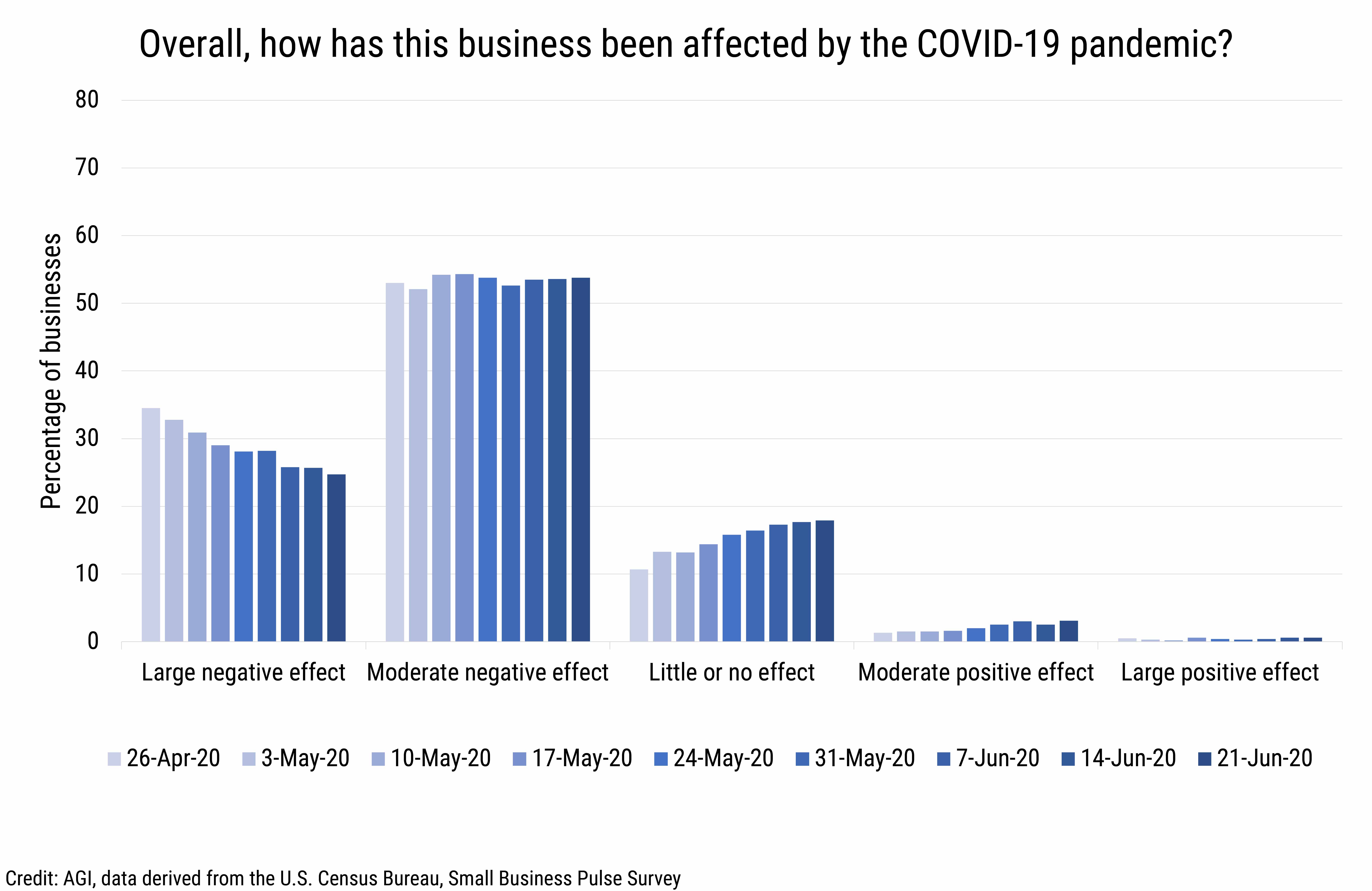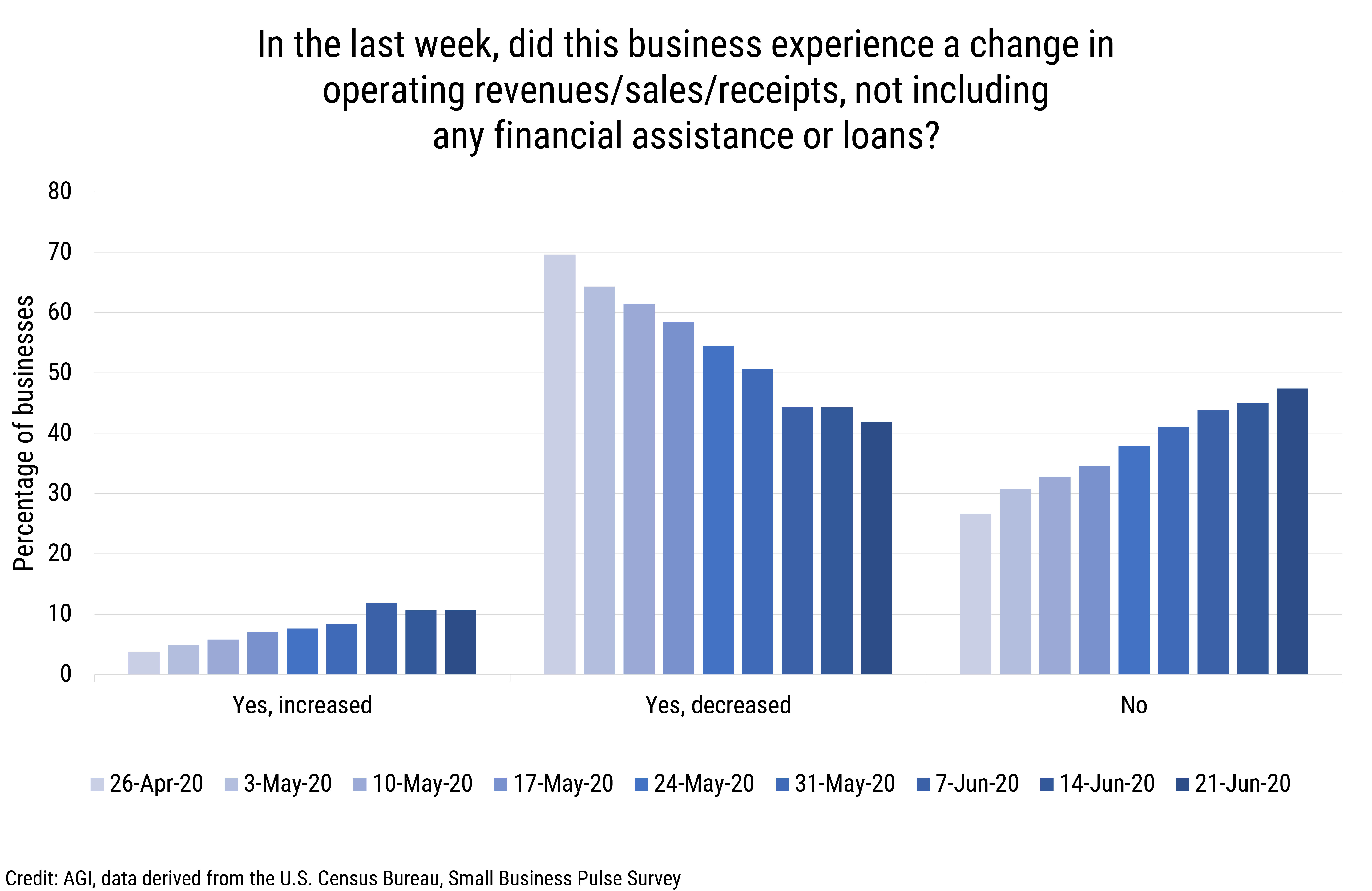Data Brief 2020-014 | August 10, 2020 | Written and compiled by Leila Gonzales and Christopher Keane, AGI, August 2020
Download Data Brief
COVID-19 Impacts to Small Businesses in the Professional, Scientific, and Technical Services Sector
To capture COVID-19 impacts to small businesses, the U.S. Census Bureau
deployed the weekly Small Business Pulse Survey from April 26, 2020 to
June 27, 2020. The survey specifically targeted non-farm,
single-location businesses with receipts greater than or equal to
$1,000 and with less than 500 employees. The survey provides industry
sector data about business operations, revenue, financial assistance,
supply chain disruptions, and employee staffing. Although the data is
aggregated at broad industry sector and sub-sector levels, it is useful
to examine trends in COVID-19 impacts to small businesses within the
professional, scientific, and technical services sector, a key sector
in which geoscientists work. The survey’s data also provides a backdrop
against which to compare the finer-resolution data from the AGI
Geoscience COVID-19 study.
Throughout the study period, just over half of small businesses within
the professional, scientific, and technical services sector indicated
moderate negative effects from the COVID-19 pandemic. The percentage of
small businesses reporting large negative effects declined from 35% at
the end of April to 25% the end of June, while those reporting little to
no effect increased from 11% to 18% of businesses over the same period.

DB_2020-014 chart 01: Overall COVID-19 impacts to businesses (credit: AGI, data derived from the U.S. Census Bureau, Small Business Pulse Survey)
AGI
Financial assistance
The Paycheck Protection Program (PPP) and Economic Injury Disaster Loans
(EIDL) were the most common sources from which financial assistance was
requested by small businesses in this sector. Just over one-fifth of
businesses did not request financial assistance from any sources since
March 13th, and by the end of June, 28% of businesses had not received
any financial assistance from federal programs.

DB_2020-014 chart 02: Sources of Requested Financial Aid (credit: AGI, data derived from the U.S. Census Bureau, Small Business Pulse Survey)
AGI

DB_2020-014 chart 03: Sources of Received Financial Aid (credit: AGI, data derived from the U.S. Census Bureau, Small Business Pulse Survey)
AGI
Financial health
Declines in operating revenues were reported by 70% of small businesses
at the end of April 2020, and by just over 40% of businesses at the end
of June; however, substantial declines in operating revenues and cash on
hand were not apparent in the survey data. The percentage of businesses
reporting one month or less of cash on hand decreased from one-third to
one-fifth from the end of April through the end of June. Concurrently
the percentage of businesses reporting three or more months of cash on
hand increased from just 24% to 36% over the same period. The percentage
of small businesses reporting $50,000 or less in monthly operating
revenues, sales, and receipts decreased from 49% of businesses in
mid-May to 47% of businesses at the end of June. Furthermore, over 95%
of businesses reported that they did not miss any loan payments and over
85% reported not missing any other scheduled payments over this period.

DB_2020-014 chart 04: Changes in Operating Revenues (credit: AGI, data derived from the U.S. Census Bureau, Small Business Pulse Survey)
AGI
Business operations
Interruptions to business operations were minimal across this industry.
The percentage of businesses temporarily closing locations for at least
one day per week declined from 32% at the end of April to 16% at the end
of June. While staffing remained strong over this period with over 85%
of businesses reporting no reduction in employee staffing, the
percentage of businesses reporting no change in employee hours increased
from 53% at the end of April to 74% at the end of June. In addition, the
percentage of businesses reporting supply chain disruptions decreased
from 28% to 16% over this period.
We will continue to provide current snapshots on the impacts of COVID-19
on the geoscience enterprise throughout the year. For more information,
and to participate in the study, please visit:
www.americangeosciences.org/workforce/covid19
Funding for this project is provided by the National Science Foundation
(Award #2029570). The results and interpretation of the survey are the
views of the American Geosciences Institute and not those of the
National Science Foundation.